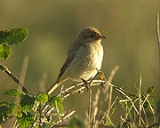
Isabelline Shrike
Encyclopedia
The Isabelline Shrike is a member of the shrike
family (Laniidae). It is the eastern equivalent of the Red-backed Shrike
(Lanius collurio) with which it used to be considered conspecific.
The Isabelline Shrike breeds in south Siberia
and central Asia
(race L. i. phoenicuroides, known as Turkestan Shrike) and China
(race L. i. isabellinus, known as Daurian Shrike (after the Dauria region)) and winters in the tropics. These two races are sometimes regarded as separate species. It is a rare vagrant to western Europe
, including Great Britain
, usually in autumn.
This migratory
medium-sized passerine
eats large insects, small birds, rodents and lizards. Like other shrikes it hunts from prominent perches, and impales corpses on thorns or barbed wire as a larder. It breeds in open cultivated country, preferably with thorn bushes.
The plumage is isabelline
, the sandy colour which gives rise to its name. It has a red tail. Young birds can be distinguished from young Red-backed Shrikes by the much sparser vermiculations on the underparts.
Shrike
Shrikes are passerine birds of the family Laniidae. The family is composed of thirty-one species in three genera. The family name, and that of the largest genus, Lanius, is derived from the Latin word for "butcher", and some shrikes were also known as "butcher birds" because of their feeding habits...
family (Laniidae). It is the eastern equivalent of the Red-backed Shrike
Red-backed Shrike
The Red-backed Shrike is a carnivorous passerine bird and member of the shrike family Laniidae.English common names include 'Wariangle' and 'worrier'.-Description:...
(Lanius collurio) with which it used to be considered conspecific.
The Isabelline Shrike breeds in south Siberia
Siberia
Siberia is an extensive region constituting almost all of Northern Asia. Comprising the central and eastern portion of the Russian Federation, it was part of the Soviet Union from its beginning, as its predecessor states, the Tsardom of Russia and the Russian Empire, conquered it during the 16th...
and central Asia
Asia
Asia is the world's largest and most populous continent, located primarily in the eastern and northern hemispheres. It covers 8.7% of the Earth's total surface area and with approximately 3.879 billion people, it hosts 60% of the world's current human population...
(race L. i. phoenicuroides, known as Turkestan Shrike) and China
China
Chinese civilization may refer to:* China for more general discussion of the country.* Chinese culture* Greater China, the transnational community of ethnic Chinese.* History of China* Sinosphere, the area historically affected by Chinese culture...
(race L. i. isabellinus, known as Daurian Shrike (after the Dauria region)) and winters in the tropics. These two races are sometimes regarded as separate species. It is a rare vagrant to western Europe
Europe
Europe is, by convention, one of the world's seven continents. Comprising the westernmost peninsula of Eurasia, Europe is generally 'divided' from Asia to its east by the watershed divides of the Ural and Caucasus Mountains, the Ural River, the Caspian and Black Seas, and the waterways connecting...
, including Great Britain
Great Britain
Great Britain or Britain is an island situated to the northwest of Continental Europe. It is the ninth largest island in the world, and the largest European island, as well as the largest of the British Isles...
, usually in autumn.
This migratory
Bird migration
Bird migration is the regular seasonal journey undertaken by many species of birds. Bird movements include those made in response to changes in food availability, habitat or weather. Sometimes, journeys are not termed "true migration" because they are irregular or in only one direction...
medium-sized passerine
Passerine
A passerine is a bird of the order Passeriformes, which includes more than half of all bird species. Sometimes known as perching birds or, less accurately, as songbirds, the passerines form one of the most diverse terrestrial vertebrate orders: with over 5,000 identified species, it has roughly...
eats large insects, small birds, rodents and lizards. Like other shrikes it hunts from prominent perches, and impales corpses on thorns or barbed wire as a larder. It breeds in open cultivated country, preferably with thorn bushes.
The plumage is isabelline
Isabelline (colour)
Isabelline , sometimes called Isabella, is a colour, variously described as pale grey-yellow, pale fawn, pale cream-brown or parchment....
, the sandy colour which gives rise to its name. It has a red tail. Young birds can be distinguished from young Red-backed Shrikes by the much sparser vermiculations on the underparts.
Identification
- Worfolk, Tim (2000) Identification of red-backed, isabelline and brown shrikes Dutch BirdingDutch BirdingDutch Birding is an ornithological magazine published by the Dutch Birding Association. Its editor is Arnoud van den Berg. It was first published in 1979....
22 (6): 323-362
Vagrant occurrences
- Message, Stephen (2001) The Turkestan Shrike in Kent Birding WorldBirding WorldBirding World is a monthly birding magazine published in the United Kingdom. It is the magazine of the Bird Information Service, based at Cley next the Sea, Norfolk....
14(10):432-434
External links
- Oiseaux Pictures

